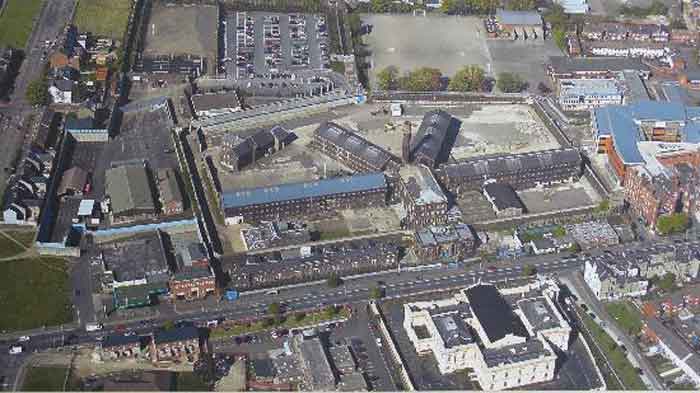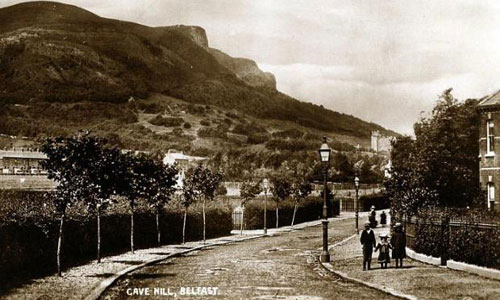ANDREW TIPPING picks the most spooky places to visit in Belfast, the capital of Northern Ireland
Belfast is an old city with a rich and, at times, very tragic history. As with any place with tragic events, Belfast has its very own haunted tradition.
Ghost stories and tales of haunted locales are alive and well in today’s Belfast. There have been many publications throughout the years documenting the various stories of spirits and spectres but almost all of these stories focus on the traditional ghost stories of my grandparents’ day.
Indeed if one was to look at the ghost stories that exist in Belfast almost all of these are from the 19th and early 20th century. Perhaps it was the outbreak of the Troubles, the bitter period of intercommunal violence, in 1969 that caused people to focus on getting through the nastiness of everyday life rather than pausing to think about the things that go bump in the night.
The days of violence in Belfast are thankfully mostly confined to the history books and a kind of renaissance of ghostly tales and other unusual occurrences have started to emerge.
Today there are far more haunted locations to visit in Belfast – nearly every building has a ghost story attached to it. I feel that the five locations presented here are the most famous and are the most accessible to the visitor.
1. The Crumlin Road Gaol
Although I said I would not go over old ground, the Crumlin Road Gaol is perhaps the most famous of Belfast’s haunted places.
Almost everyone in Belfast has heard a spooky tale of this grim and foreboding place.
I have visited it several times in the past and it certainly has a unnerving atmosphere to it. In operation from 1846 to 1996, the prison served as holding place for some of Belfast’s most notorious prisoners.
Although the place has a reputation for being a prison where many prisoners were executed by hanging, in reality only a tiny percentage of prisoners held over the years actually met the hangman in Crumlin – seventeen out of tens of thousands over the 150 years it was open.
Its reputation is probably such due to the fact that so many of Northern Ireland’s famous personalities served time being its bars including future First and Deputy First Ministers of Northern Ireland, the late Ian Paisley and Martin McGuinness.
The Gaol today is famous for its hauntings and is home to one of the finest ghost tours in Belfast.

Amongst the hauntings there are a few tales that stick out as particularly interesting.
One is said to be of an American Jew who was hanged for a crime he did not commit.
Allegedly his ghost stalks the prison wings and wrought iron walkways of the Gaol. Oddly enough most of the sightings were reported by the prison wardens rather than inmates.
Read: The Haunted Back Road from Belfast to Lisburn
Another tale is of a young man who committed suicide so as to avoid punishment from the hangman.
According to the legend the cries of a young boy could be heard at night – a truly unnerving experience that would have shook even the most hardened of criminals.
Although the prison has shut its doors for nearly ten years now, the stories of ghosts continue.
Clearly the spirits haven’t taken notice of the prison’s closure!
2. The Belvoir Park Hospital
This is a particularly new spooky location. Most of Belfast’s stories of spooky locations stem from the 19th and early 20th century so when I first heard about this place I was amazed.
Belvoir Park is a large expanse of woodland in the south part of Belfast and by all accounts it is a lovely place to take the dog for a walk on a Sunday afternoon. However the idyllic woodland scene hides a dark side almost in plain sight. Right beside this beautiful forest is the site of the old Belvoir Park hospital.
The hospital was founded in 1906 as the Purdysburn Fever Hospital but was later named the Belvoir Park hospital in the early 1960s. For a time it was the only radiotherapy hospital in Northern Ireland and we can be sure it had its fair share of death and misery.
However, it was decided in the early 2000s to transfer the responsibility of cancer treatment to the City Hospital near the University Quarter of the city and so Belvoir Park was closed in 2006.
This was not the end of Belvoir Park hospital, however. It was kept intact to act as an isolation centre in case of an outbreak of a seriously infectious disease in the city.
Private security was brought in and the site was not demolished or redeveloped in any way. How Belvoir Park came to my attention at first was through the security company that I worked for as it was the company that I happen to work for at the time whilst a student. I was told stories by colleagues that the site was home to very strange activity.
These stories were fairly disturbing to say the least and included tales of shadowy figures running amok in the site despite the guards’ best attempts to stop them, reports of strange shrines being found at the site of stream that ran near the hospital grounds and even the discovery of mutilated animal corpses.
3. Friar’s Bush Graveyard
In the centre of the city’s University Quarter, which is home to Queen’s University and the Ulster Museum, lies a graveyard with a history stretching back to a time when Belfast itself had yet been founded.
The site that would become Friar’s Bush Graveyard has been in use as a burial site since at least the 5th century AD. In the 1840s, at the height of the cholera outbreak, several hundred corpses were dumped in a mass grave in the centre of graveyard.
It can still be seen today as a large and unnatural looking mound. Over the years there have been numerous stories of ghosts and the like, as with all graveyards, but one that is perhaps most striking happened not in the graveyard but under it.
Across the road from Friar’s Bush is the David Kerr building, a part of the Queen’s University. Under the ground lies a maintenance tunnel which connects the building with the Ashby Building, another QUB facility.
On one occasion sometime in the late 1990s, a worker in the tunnel felt someone touch him in the darkness of the tunnel. Turning round there was no one there. Other spooky goings on in the tunnel has led to university staff apparently refusing to go into the tunnel alone whilst describing a highly unnatural and disturbing coldness.
4. The Giant’s Ring
In the foothills that surround Belfast is the infamous pre-Christian religious site known as the Giant’s Ring. The site is truly ancient dating back to around 2700BC – making it older than the Pyramids in Egypt.
The site was most likely used by a cult for the veneration of the dead. Like many pagan sites across Ireland, it was avoided for many years by Christians. However, it eventually became used as a race course in the 18th century and then finally turned into a heritage site in the 20th century. There have been a number of stories of unusual activity occurring at the site.
In one incident in the early 1990s a family reportedly encountered a deep and impenetrable mist that suddenly appeared. Supposedly every time they tried to escape the fog to head to their car they kept arriving at the centre of the ring at a structure known as a dolmen (a large upright stone). Eventually they managed to leave the site but left with a sense of dread.
Other stories that surround the Giant’s Ring and the extended Shaw’s Bridge area include tales of it being used by sinister cults for nefarious purposes – some have even claimed that the sacrifice of children to dark gods is practiced here. Certainly there has never been any concrete proof of these tales but if there is any grounding to the reports then the Giant’s Ring is one of the most sinister sites in Belfast.
5. Cavehill
Looming high above the city is the iconic shape of Cavehill with its infamous “Napoleon’s Nose” rock formation – supposedly named for its likeness of the erstwhile Emperor of the French.
Cavehill has been used as a refuge by humans as far back as the Iron Age and takes its name from a series of three caves built into the rock itself. In 1913 Cavehill became a hub of paranormal activity and hundreds of Belfast folk flocked to it in hopes of spotting a ghost.
According to the reports at the time, during the night a wailing sound could be heard emanating from the nearby woods at Cavehill. Some people tried to track the source of the wail and apparently every time they neared the source of the noises the sound would simply stop.
Two years later, in June 1915, a couple out for a walk spotted what appeared to be a floating man within the trees. When the floating man moved towards the couple the y ran.
Of the couple, the man had to be treated for severe cuts and bruises. Clearly the couple had seen something that frightened them enough to run without care for falling or being snagged on branches. Numerous sightings of a “floating” or “hovering” man continued for the next few years.
Then in 1922 a couple out for a walk discovered a bizarre looking rock – to their horror it was discovered to be an actual human skull. Reporting their grisly discovery to the police, the RUC investigated and found a full human skeleton right in the area where the ghostly sightings were reported.
Apparently the skeleton was identified as being of a certain Mr John Scott who had disappeared several years previously. Scott was determined to have committed suicide on Cavehill.
The remains were then given a full burial and the ghost sightings and wailings ceased.
Have you seen a ghost in Belfast? Tell us about it in the comments section below!




I live up the street from belvoir park hospital and it certainly wasn’t left as an isolation centre and I know that for a fact as a lot of my family worked there.. It couldn’t be demolished because of the radiation wards so had to be left for 10 years before they could build. Also I have been inside plenty of times the last visit was only a couple of weeks ago you can get in through the back gates where there is no guards, The place is completely trashed and has been since 2008. The roofs are falling down inside there is mold everywhere the carpet is wrecked and so on, Pretty much every window in the place is broke and every door broke open so it definitely wasn’t kept for further use or the building would have been looked after. Or maybe it’s just the crap security team they are using lol Now that the 10 years has passed they have sold the land and developers are planning to turn them into apparments and build on the land around it. 250,000 acres where sold so it was a lot of land. I just hope they stick to their word and keep the buildings as they are a big part of belfasts history. Would be a shame to see them knocked down for new apartments when they would make cracker ones. But no it definitely isn’t an isolation centre. You should check out the abandoned church’s at purdysburn they are far more creepy due to the fact there is a kicked through door that leads into creepy underground tunnels that go all over purdysburn. Strange stuff when your down there lol
Omg where is this abandoned church id love to visit that can you give me the postcode for it please! Thanks
Does anyone of an abandoned facility down Newforge Lane near kings hall? Me & and my friends went to the site around 10+ years ago and it was the spookiest/creepy abandoned place I’ve been too in Northern Ireland. Was recently telling someone about it but could never get a name or record of it and it’s now since been demolished and built over.